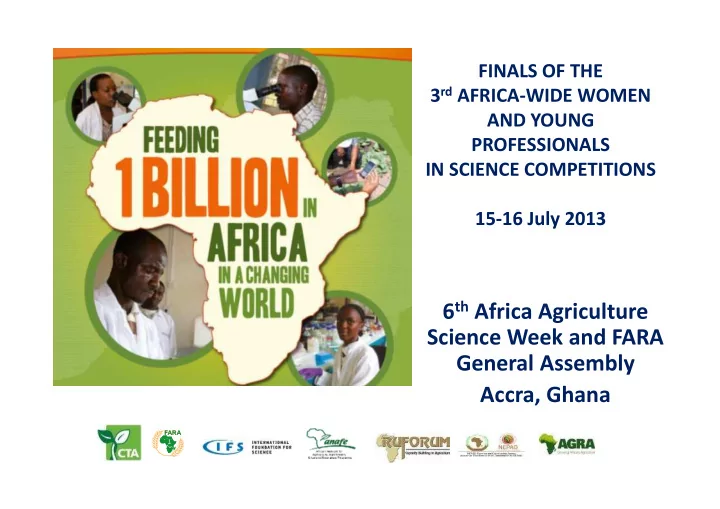

FINALS OF THE 3 rd AFRICA-WIDE WOMEN AND YOUNG PROFESSIONALS IN SCIENCE COMPETITIONS 15-16 July 2013 6 th Africa Agriculture Science Week and FARA General Assembly Accra, Ghana
������������������������������ ��������� ���������������������� ����������������������������������� S.M. Kabiri, C. Ebong, P. Kudsk, S.K. Mathiassen, P. Lusembo, G. S. Byenkya, H. Kasigwa and R. Kabanyoro ��� ������ �������
Importance of rangelands in Uganda • Used for grazing wild and domestic The cattle corridor herbivores, providing the cheapest source of nutrients • Supports 90% of the national cattle population. • 85% of total milk and beef is produced from indigenous cattle fed on natural rangeland pasture. 84,000 Km 2 of Uganda’s 236,000 Km 2 • Pastoralism contributes 8% of Uganda’s GDP
Cymbopogon afronardus � C. afronardus is an invasive noxious weed that is rapidly invading the rangelands � It is a tall tufted perennial grass that naturally establishes from seed � It grows fast and builds a thick, course vegetation that suppresses other plant species. � Its leaves are rough and contain aromatic oils that make it unpalatable to cattle and wild herbivores � Other Cymbopogon spp . are known to contain allelopathic properties
Cattle desperately searching for pasture under Cymbopogon tufts
Objectives of the Study Cymbopogon continues to spread rapidly and poses a threat to the rangelands and yet its current magnitude has not yet been established. i. Determine the current invasion in acreage of Cymbopogon in the Ugandan rangelands ii. Evaluate landscape characteristics it prefers and the ecological impact it has on threatened vegetation iii. Identify allelopathic properties of Cymbopogon oil extracts
Study Area ����������������� Comprises � An area 4100 Km 2 � Cattle ranches � 535,000 livestock � Lake Mburo National Game park � Wild grazers; zebras, antelopes, impalas and buffaloes � Dense Cymbopogon coverage
Obj 1: Spatial distribution of Cymbopogon Ground truthing Remote sensing data 85-100% Cymbopogon Other vegetation Landsat Image, 5th June 2009, Source: Global land cover facility (GLCF), www.landcover.org
Evaluation of spectral signatures � lowest reflectance Cymbopogon values at the mid infra- red for Grasslands Cymbopogon � signifies high water content in foliage Reflectance � distinguished from other vegetation Landsat spectral bands Forests Landsat bands
Spatial distribution maps-83% accuracy � 2500 km 2 � 9300 km 2 � 61% of Kiruhura � 11% of Uganda rangelands
Obj.2 Landscape FAO Africover characteristics and vegetation map for Ecological impact Mbarara region overlay Kiruhura Cymbopogon cover overlay 250 m digital terrain model
Landscape characteristics Cymbopogon had 76 % distribution on steep slopes
Cymbopogon preference for open canopy Savannah and steep slopes
Obj. 3 Allelopathic properties of Cymbopogon 15 days 1 g Cymbopogon leaf, Rangeland Volatile oil 10 ml ethanol (70% extract v/v). Per 100 ml, H 2 0 Petri dishes (5-7 days) 0.6 1.2 2.4 4.8 6% Lolium perenne Cyperus rotundus
Allelopathy to L. perenne and C. rotundus 500 Germination % Vigour index 100 400 L. perenne L. perenne a a 80 Vigour index C. rotundus C. rotundus 300 c b 60 G % b 200 a d 40 c a b 100 20 b c c d 0 0 0 0.6 1.2 2.4 4.8 6 0 0.6 1.2 2.4 4.8 6 Shoot length Root length 5 shoot length (cm) 5 4 root length (cm) a 4 3 a b 3 c 2 b 2 c 1 a d 1 d a b a b c 0 0 0 0.6 1.2 2.4 4.8 6 0 0.6 1.2 2.4 4.8 6 Cymbopogon extact dilution (%v/v) Cymbopogon extract dilution (% v/v) Potential for bio-herbicide formulations
Communication strategy Objective � To raise awareness that Cymbopogon is a dangerous weed Key message � Cymbopogon afronardus is rapidly increasing and is threatening ecosystem services provided by the rangelands
Leaflets GIS maps
Stakeholders targeted Rangeland Experts Extension Policy Local government makers Pastoralists Farmers � Set policy guidelines � GIS maps � Facilitate finance for research � Leaflets in local to design control languages management strategies
Impact � Quantified the state of the environment of Uganda’s rangelands in regard to invasiveness of Cymbopogon. � Established a basis for monitoring future spread. � Will aid in drafting the National invasive species strategy, action plan and policy guidelines. “Risk Analysis Procedures, Early Detection and Rapid Response Systems for quarantine authorities”.
Acknowledgments • Deepest gratefulness to CTA, FARA, IFS, ANAFE, RUFORUM, NPCA, AGRA for organising and sponsoring this Science competition • Heartfelt gratitude to ENDURE, DANIDA, LSRP, ASPS, GOU, NARO and IDA of the World Bank for funding this research. • Earnest appreciation to presiding judges, Prof. Ameenah Gurib- Fakim, Ms Marjorie Niyitegeka Kyomuhendo , Dr Demba Farba Thank you for Mbaye , Prof. Robert Kariuki your attention Obura, Prof. Abdoulaye Gouro
Recommend
More recommend